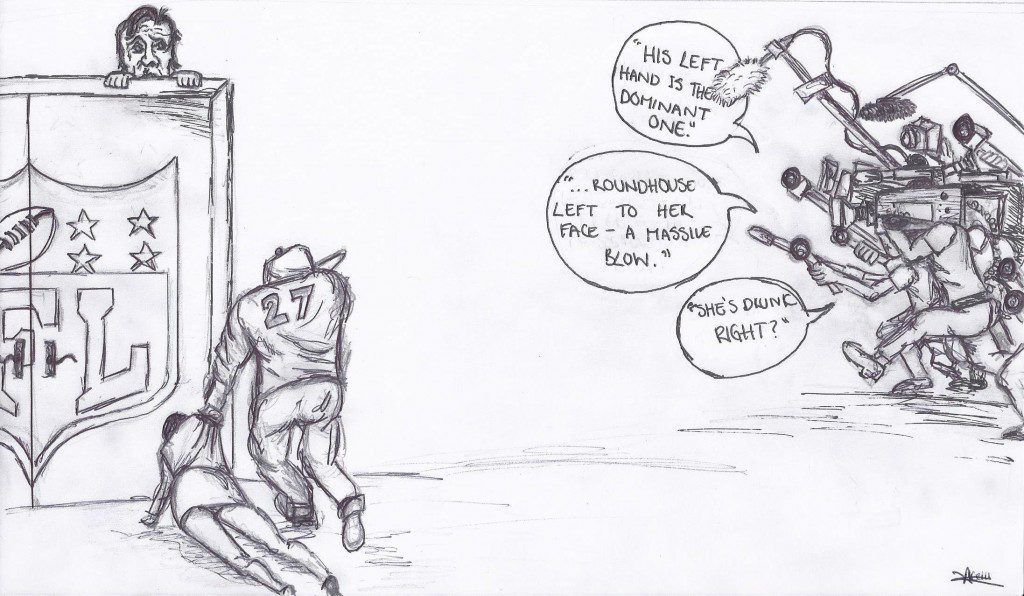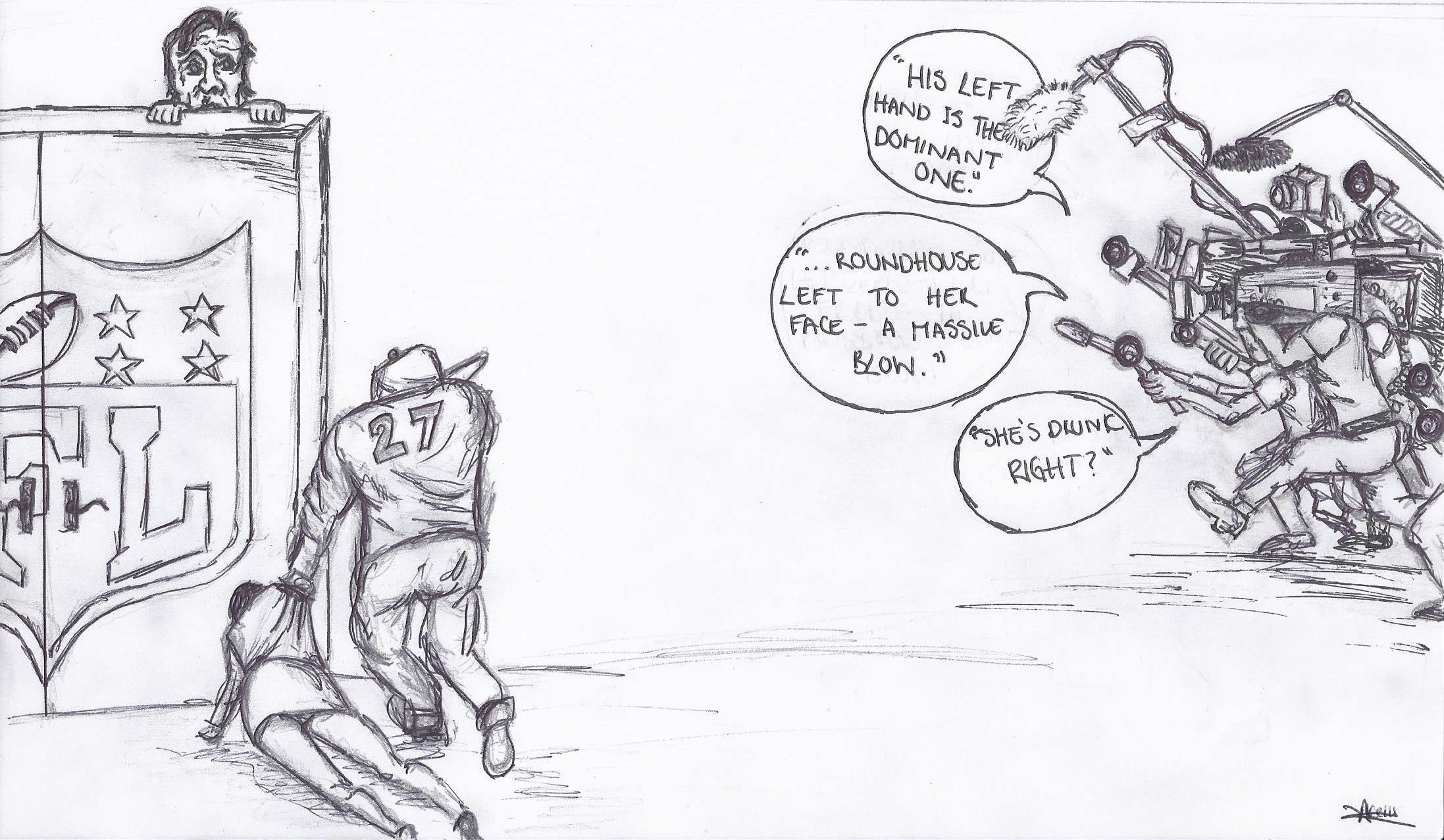By Alanna Kelly
There are many viral videos that The Globe and Mail columnist Elizabeth Renzetti refuses to watch, but she had to see the video that showed Ray Rice punching his then-fiancée Janay Palmer. As disgusting as it was, it showed an issue that people needed to talk about. The couple had just left a dinner party, where they had been arguing. Once inside their hotel elevator, Rice punched Palmer in the head and sent her into the elevator wall before she fell to the floor unconscious. The first video showed him carrying her out of an elevator like a doll. The second video showed Rice, then a Baltimore Ravens running back, hitting her.
Although sports journalists were the first ones to jump on the initial video, once the second video came out in February, the coverage spread rapidly. Most of that reporting and commentary missed an opportunity to step back, look at the bigger picture and consider a difficult subject in a responsible way. Instead, many of the headlines and front-page stories about the Rices served as clickbait instead of addressing domestic abuse.
Some sports journalists wrote about the assault like they were reporting a sporting event. They explained the speed and strength of Rice’s punch while giving details such as how he used his dominant football arm. Some described it as “professional quality,” analyzing the incident like they would a boxer in the ring. “That is, his left hand is the dominant one. The one he used to knock out his now-wife,” wrote the National Post’s Scott Stinson, who then went on to question why Janay would even stay with Rice. Similarly, John Kryk of the Toronto Sun wrote: “Rice pre-empting her move with a sudden roundhouse left to her face—a massive blow.”
Meanwhile, some headlines featured sensational words such as “slugging,” and the Sun ran “Ravens cut Ray Rice after knockout video surfaces.” The Calgary Herald and The Vancouver Sun posted a video with the headline “Longer version of Ray Rice video shows couple screaming, spitting and ‘She’s drunk, right?’” even though no one in the video mentions Palmer being drunk. The Globe published a similar headline, but left out the ‘She’s drunk, right?’ part.

Under the headlines, there was a sense of breathless reporting about the video. Some sports journalists scratched only the surface of issues surrounding domestic abuse in sports and instead focused on analyzing why Palmer would stay with Rice. “As much as sports media is more diverse than it ever was,” says Morgan Campbell of the Toronto Star, “it is very phallocentric, very male-dominant and I feel that has a lot to do with it.”
Domestic violence is a nine-headed monster for a sports journalist to cover, says The Vancouver Sun’s Cam Cole, who has been writing sports columns for several papers since 1986. He says covering the deeper issue is something that many sports reporters don’t have enough time to do properly, and they are afraid to tackle it because it is so big. “It is probably the one big omission or oversight, that in the hunger to hang the people responsible,” says Cole, “we kind of forgot about who got beat up here.”
Renzetti says sportswriters may not even know what language they should be using. But if they don’t feel comfortable talking about domestic abuse, they perpetuate the problem. “They have to be the one to carry the ball on this issue, they have to man up,” she says with a chuckle. She rejects the idea that only specific journalists can write about certain topics. If someone has something to say, he or she should cover it.
But many newsrooms and journalists seemed to skip the discussion about the best course of action and posted the videos without any apparent thought to spousal abuse. What was missing and should have been done was a quick story breaking down what happened in the video and then a wide array of columns packaged with insight exploring the complexity of what happened.
One writer was able to convey all of these things to his readers and he rarely watches NFL football. Just down the street from Ian Brown’s home, in an upscale downtown Toronto neighbourhood, is a women’s shelter. On his way to the office, the Globe writer stopped on the doorstep of the shelter. He didn’t think anyone would answer, but knocked anyway. He spoke to three women who had similar stories of abuse, though he wrote about only one of them. “It makes you feel sad about it over and over,” says Brown. “And yet we don’t really solve the problem.”
He had time to think about the story and was able to respond after it had unfolded. An abuse counsellor named Noa Ashkenazi questioned Brown on why no one was asking, “Why do men hit?” Yet she had been asked over 100 times why women stay with their abusers.
Brown was not an expert on domestic assault, or sports for that matter, and had just 1,200 words—not nearly enough, in his mind—to make his point, but after speaking to Ashkenazi, he knew what his piece would be about. He reached out to Janay Rice (but heard nothing back), called six or seven agencies that help abused women and attempted to speak with men who had also been abused. In the story, Brown reported the facts and touched on the shame men feel about domestic abuse. And, he questioned why a man would hit the woman he loves.
He points out that now more than ever, readers think reporters need to take a moral stance on issues. For him, it is telling the story in the most appropriate way. “Most of the time that means not taking a stance,” says Brown. “It means observing what you see before you and conveying it with relish.”
People will move on from Ray, from the eight seconds it took him to knock his wife unconscious; the world will find something else to focus on. But the story was an opportunity for journalists—including sportswriters—to learn that the stories they tell can shape the way people think.
About the author
Alanna Kelly is the Spring 2015 senior online editor. She will talk and play any sport you throw her way. She also has an interest in multi-platform and photo journalism.
